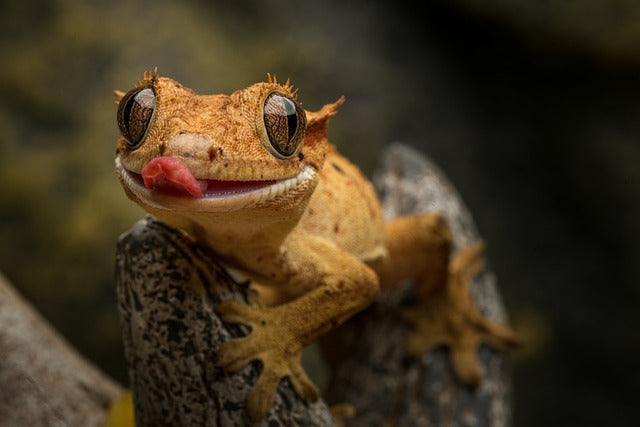Crested Gecko (Correlophus ciliatus) Care Sheet
Quick Facts
Scientific Name: Correlophus ciliatus
Common Names: Crested Gecko, Eyelash Gecko
Origin: New Caledonia
Adult Size: 16–22 cm (6–9 inches) total length, including tail
Lifespan: 15–20 years in captivity
Sex Differences: Males are typically slimmer with larger hemipenal bulges at the base of the tail; females are rounder and larger-bodied with smaller tails
Beginner Suitability: Easy to Moderate – hardy, but require proper humidity and diet management
Enclosure
Size: Juveniles can be housed in 30 cm x 30 cm x 45 cm (12 x 12 x 18 inches). Adults require a minimum of 45 cm x 45 cm x 60 cm (18 x 18 x 24 inches). Taller enclosures are preferred due to their arboreal nature.
Substrate: Use coconut fibre, orchid bark, or bioactive substrate for humidity retention. Avoid substrates that can cause impaction if ingested.
Hides: Provide multiple hides at different heights and temperature zones. Include foliage or artificial plants for climbing and security.
Heating: Crested Geckos are nocturnal and do not require high daytime basking temperatures. Maintain a hot side of 25–28°C and a cool side of 20–22°C. Night temperatures can drop to 18–20°C. Avoid direct hot basking lamps.
Lighting: UVB is optional but beneficial. Provide low-level UVB (2–5%) if using fluorescent tubes. Maintain a 12-hour light / 12-hour dark cycle.
Humidity: Maintain 50–70% humidity. Mist the enclosure daily or as needed to prevent dehydration and aid shedding. Ensure ventilation to prevent mould growth.
Diet
Primary Diet Type: Omnivore
Food Items: Feed a commercial powdered Crested Gecko diet (PGD) as the staple. Supplement occasionally with live insects such as crickets or small roaches, gut-loaded and appropriately sized. Offer pureed fruit such as mashed banana or papaya as a treat.
Feeding Frequency: Juveniles: every day. Adults: every 2–3 days, focusing on commercial diet as staple.
Feeding Troubleshooting: Ensure insects are appropriately sized (no larger than the space between the gecko’s eyes). Mix powdered diet according to manufacturer’s instructions. Crested Geckos can be picky—changing fruit flavours or mixing insects can help encourage feeding. Dust insects with calcium powder twice per week.
Water
Provide a shallow water dish with clean water at all times. Mist daily to allow drinking from droplets on leaves.
Behavior And Handling
Generally docile but can be skittish. Support the body fully when handling and avoid sudden movements. Best handled at night when active. Avoid handling immediately after feeding to prevent stress or regurgitation.
Enrichment
Include vertical climbing structures such as branches, cork tubes, and foliage. Provide hides at multiple heights and textured surfaces to allow natural climbing, jumping, and exploration behaviours.
Health
Signs of illness include lethargy, weight loss, lack of appetite, retained shed, swollen limbs or toes, and abnormal stool. Ensure correct humidity and temperature to support shedding. Consult a reptile-specialist veterinarian if issues persist.
Lifespan
Typically 15–20 years in captivity with proper care, making them a long-term commitment.
Legality In The UK
Crested Geckos are legal to keep in the UK. No licence is required for private ownership. Owners must comply with Welfare of Animals regulations.
Difficulty Bars (Relative)
| Category | Level |
|---|---|
| Feeding | ███▁▁ Moderate (requires commercial diet plus occasional insects) |
| Handling | ████▁ Easy (docile but skittish) |
| Humidity Needs | ████▁ Moderate (daily misting required) |
| Enclosure Setup | ████▁ Moderate (vertical space and climbing structures essential) |
| Beginner Suitability | ████▁ Moderate (suitable for attentive beginners) |

